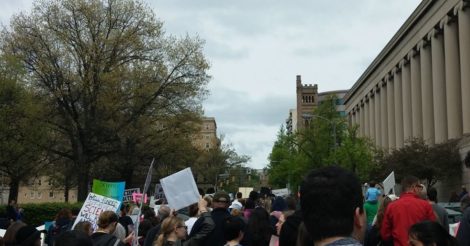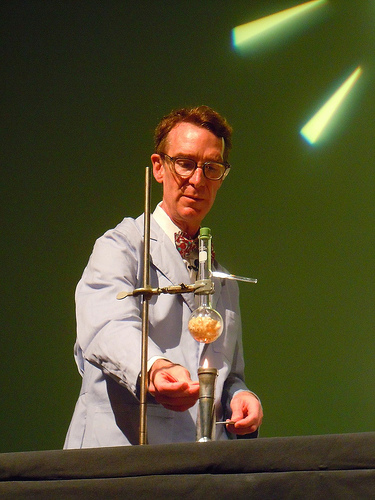
On Saturday, for Earth Day, activists in 600 cities around the world assembled in support of science education, science funding and science-driven policy. I participated in the Pittsburgh event. I wanted to express my support for common goals. I wanted to participate with my local science and technology community, which has provided me with education and employment and has been a vital part of the region in the post-steel era. And I wanted to experience the event for myself, to see who would be there and hear what they had to say and how they said it. The walking would also provide a good opportunity to reflect on science in the public sphere.
I recognize that a march is an imperfect tool for building the cross-community bridges which were among the organizers’ goals. The number of recent marches responding to the United States’ administration change and the fact that they occur mainly in cities can give the impression that these events are by and for liberals. And despite the assertions that science is not a “liberal conspiracy” and similar slogans, I’d be hard-pressed to imagine conservatives, particularly Trump supporters, feeling comfortable at the Pittsburgh march, simply based on the number of signs challenging Trump or the Republican party by name.
At the same time, I can see some nuance between opposing an entire party’s every policy simply because they are the other team and challenging specific policy objectives and decisions by specific leaders because they are contrary to the conclusions of domain experts. And I saw some evidence of such nuance at the Pittsburgh event. For example, within the main body of participants were a few advocating recognition of human life beginning at conception on purely scientific grounds. Whatever other views they might have, they clearly felt it was possible to participate in the march in support of a cause many would associate with conservatives.
While I might have wished to communicate a nuanced message about the relative merits of different forms of engagement and activism, a choice to participate or not may really only be able to get across a single bit of information. And it’s even harder to say much if you don’t show up and aren’t part of the conversation at all. Since I do want to see science contribute to the public good, I do want public policy to be informed by scientific evidence, I do want broad access to quality science education, I do want a plurality of perspectives contributing to science, and I do want my tax dollars to fund scientific research, I felt it was reasonable to attend.
Of course, there’s an interesting question of whether a march can or will actually advance any of those goals. In the march literature, I didn’t see much in the way of evidence to support this particular policy decision. That’s not to say there isn’t any or that there aren’t direct or indirect benefits to marching. I just thought that given some of the rhetoric about the superiority of science and evidence-based decision making, the rationale for marching would reflect that focus.
I am reminded of this brief piece published recently calling for wider engagement with the philosophical discipline of epistemology, the study of how we know what we know. It was encouraging to see appreciation for the topic in a high profile science publication, at a time when public pro-science rhetoric has not always been positive about philosophy. Amid the hype for science, some humility about the limits of science and recognition of other ways of knowing would be welcome inclusions and possibly help with the bridge building.
Of course, I am especially interested in bridges between the scientific community and religious communities. I was glad to see the AAAS Dialogue on Science, Ethics and Religion actively connected to the rally in Washington, DC. The very existence of such a center within one of the world’s largest scientific associations remains a source of encouragement. And I was pleased to hear from colleagues in other cities that communities of faith were visible and welcomed participants.

 )
)My own experience in Pittsburgh was less positive in that respect. While a small minority, the few signs I saw with any sort of religious connotations sought to distance science from religion. There were variations on the theme that religion is a myth and belief or faith is the opposite of evidence-based reasoning. A few signs co-opted Biblical language. My favorite of these was one reading “In the beginning was GEOLOGY.” I couldn’t help but wonder, if we’re going to play that game, then surely what came first was something like high energy particle physics; it took a long time for stars to form and conduct enough fusion to produce materials for rocks. Of course, these were homemade signs reflecting the views of individuals and not necessarily the organizers of the Pittsburgh or worldwide events. And nothing was so hostile as to make me personally uncomfortable or offended. But it did get me wondering whether Pittsburgh specifically could use some more publicly visible cooperation between the scientific and religious communities.
Of course, I can’t completely blame scientists for the sense that religious faith and science can’t mix. Just this week, I’ve been involved in three separate conversations which came around at some point to claiming that of course evolution is nonsense because the second law of thermodynamics says everything tends towards disorder. Now, I do like to see people applying the scientific models they have learned, thinking through their implications, and asking questions. And supporting broad access to science education means these folks are entitled to have these questions answered. But answering these same questions repeatedly can be draining, mainly because of the tenor of how they are asked. There is frequently an implication, and sometimes an outright accusation, that evolutionary biologists somehow missed out on the high school physics that everyone else clearly learned.
(The answer, in case you were wondering, has several parts. First, the Earth is not at thermal equilibrium; some parts are warmer than other parts, as anyone can experience for themselves. Second, the Earth has regular input of free energy from the sun, making it possible for the Earth and organisms on the earth to maintain a low entropy state while the universe as a whole does increase in entropy. Third, “everything tends towards disorder” is an oversimplification of the second law of thermodynamics; not every state which would colloquially be described as ordered has a lower thermodynamic entropy than related states which would be described as disordered.)
Alternatively, the folks asking these questions may not believe evolutionary biologists don’t know the physics, but instead have collectively agreed to ignore those details because it suits their naturalist agenda. Many feel left out or left behind by the scientific community, or perhaps the popular pro-science movement, because it appears to have a liberal association. I’ve written before about the recent Cosmos series and how it felt designed to discomfort Christians. I recently sampled some of Bill Nye’s new Netflix series which debuted the day before the march; while it doesn’t feel like it is speaking directly to religious viewers (despite its messianic title, Bill Nye Saves the World), its treatment of topics like climate change and sexual mores (basically conflating what is with what ought to be, which is an option but not really a scientific conclusion) offer few olive branches to conservatives.
And so we are back where we started. Not unlike the Pittsburgh march itself, which made a loop around a single block—the block occupied by the University of Pittsburgh’s Cathedral of Learning (no, its walls didn’t come tumbling down; maybe next time I’ll bring my trumpet). We probably didn’t make any progress on improving communication about science topics among communities separated by politics or worldview. But maybe we highlighted the challenges more acutely by bring them out into the streets. If everyone can see the problems, if everyone can see that there are problems, we can start figuring out solutions. After all, Pittsburghers have yet to meet the gap they can’t build a bridge over.
Andy has worn many hats in his life. He knows this is a dreadfully clichéd notion, but since it is also literally true he uses it anyway. Among his current metaphorical hats: husband of one wife, father of two teenagers, reader of science fiction and science fact, enthusiast of contemporary symphonic music, and chief science officer. Previous metaphorical hats include: comp bio postdoc, molecular biology grad student, InterVarsity chapter president (that one came with a literal hat), music store clerk, house painter, and mosquito trapper. Among his more unique literal hats: British bobby, captain’s hats (of varying levels of authenticity) of several specific vessels, a deerstalker from 221B Baker St, and a railroad engineer’s cap. His monthly Science in Review is drawn from his weekly Science Corner posts — Wednesdays, 8am (Eastern) on the Emerging Scholars Network Blog. His book Faith across the Multiverse is available from Hendrickson.

Thanks for writing, Andy!
If you’re curious about the role of marches, a good place to start would be Jennifer Earl’s video & blog literature reviews for the public on findings from social movement research in political science: https://mobilizingideas.wordpress.com/2015/11/13/informing-activists/
In brief, successful demonstrations in the US play at least three important roles. First, they play an important social norms role, by revealing to people how many people care about an issue. Second, marches have an important role in the long trajectory of a person’s civic participation; shaping an individual’s perception that they are a person who takes action on things they care about. Finally, they develop social capital that if it’s continually tended, provides a building block for more lasting change.
Great! I was hoping someone would know the answers about marches. I did think it was interesting that evidence like that wasn’t cited in the motivation for the March for Science, but maybe a series of footnotes and references would have turned off more of the general public than it would have excited. In any event, thanks!